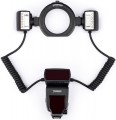Guide number
The guide number is the main characteristic that describes the power of the light pulse of the flash. It is described as the maximum distance (in metres) at which, at ISO 100 and f/1 lens speed (aperture 1), a flash is able to illuminate an "average" subject sufficiently for a normal exposure; in other words, at what distance from the flash it will be possible to normally shoot the scene at the specified ISO and aperture.
There are formulas by which, knowing the guide number, you can derive the practical shooting distance for each specific value of sensitivity and aperture. The simplest formula used to calculate the distance at ISO 100 is: S=N/f, where S is the distance, N is the guide number, f is the aperture value. For example, for a guide number of 56 and an f/2.8 lens, this distance would be 56/2.8 = 20 m. Increasing or decreasing sensitivity by a factor of 2 would increase or decrease the specified distance by approximately 1.4 times, respectively. If you need to calculate the distance as accurately as possible, you should refer to more detailed formulas that can be found in specialized sources.
Separately, it is worth noting that the leading numbers of flashes, usually, are indicated by manufacturers for specific focal lengths of lenses. This is due to the fact that the shorter the focal length and, accordingly, the wider the viewing angle, the more light is needed to illuminate the scene being shot and the more powerful the flash pulse should b...e (at the same distance). Therefore, when choosing by the guide number, it makes sense to pay attention to the focal length indicated by the manufacturer and select a model with a power reserve — especially since guide numbers are often prescribed for rather “long-range” lenses (with a focal length of about 80-100 mm in equiv. 35 mm).
Pulse duration
The duration of the pulse of light provided by the flash. This indicator can range from thousandths to hundred thousandths of a second; it is usually expressed as a fractional number with a unit in the numerator, such as 1/880 s. The human eye does not notice the difference, but in some shooting modes it can become critical. For example, to capture fast-moving scenes (such as splashing water, the flight of an insect, or the movement of machine parts) you need to choose a flash with the shortest flash duration possible — otherwise the image may be blurry.
The longest pulse duration in modern photoflashes is about 1/800 s; the minimum value can reach 1/30,000 s or even less.
Colour temperature
The colour temperature of the light emitted by the device. Most of the classic flashes have a standard colour temperature of 5500-5600 K, so this parameter is usually not given for such lamps. But on-camera light sources (see "Type") can differ markedly in this indicator, and we will talk about them.
Colour temperature characterizes the overall shade of the glow emitted by the device. At the same time, an interesting nuance is that low values \u200b\u200bcorrespond to colours that a person perceives as warm; and as the colour temperature rises, the hue shifts more and more towards cool colours. For example, for a 60 W incandescent lamp, the light of which has a pronounced yellowish colour, this parameter is approximately 2700 K, and for a fluorescent lamp that produces “daylight” light with a bluish tint, this parameter is about 7000 K.
In general, the colour temperature of lighting is one of the most important parameters when shooting: it determines the colour balance of the image "seen" by the camera. In camera settings, this indicator is called "white balance". It can also be determined automatically, however, for the most reliable colour reproduction, it is still desirable to set its values according to the known colour temperature of the lighting.
Specifically, in on-camera light sources, the colour temperature can be either constant or adjustable. In non-adjustable models, the value of this parameter is the same as in most flash units...— 5500 K, which corresponds approximately to neutral white. Adjustment also provides the possibility of at least lowering the colour temperature — usually up to 3200 K, which approximately corresponds to warm white light. In addition, occasionally there are models in which the maximum colour temperature exceeds 5500 K, reaching 6000 K and even more.
The ability to change the colour temperature can be useful not only for shooting as such, but also for “matching” the lamp with other light sources. The fact is that if several simultaneously used light sources have different colour temperatures, the colour rendition on the scene being shot will be unreliable — to the point that a monochromatic object illuminated by different lamps from different sides may look like a two-colour one. One way to avoid this is to set the colour temperature of the on-camera light to match the ambient light. However, it is worth noting here that the methods of adjusting the shades and the accuracy of such adjustment may be different. The most advanced option is to use two sets of LEDs, with a warm and cold shade of glow; By changing the brightness ratio between these sets, you can also change the overall colour temperature — and quite smoothly and accurately. Another way is to use coloured diffusers (see below), but here the adjustment is stepped, with fixed values (with and without a diffuser). In some devices, both of these methods are combined.

